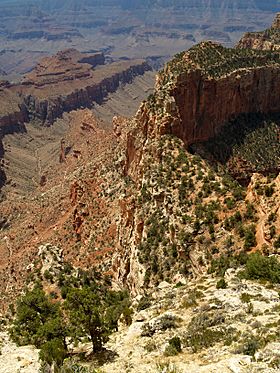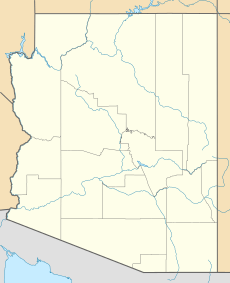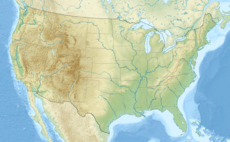Horseshoe Mesa facts for kids
Quick facts for kids Horseshoe Mesa |
|
|---|---|

(remote view)-Horseshoe Mesa at distance across the Colorado River
(Krishna Shrine and its prominence, left) |
|
| Highest point | |
| Elevation | 5,246 ft (1,599 m) |
| Prominence | 346 ft (105 m) |
| Isolation | 1.16 mi (1.87 km) |
| Parent peak | Unnamed butte |
| Geography | |
| Location | Grand Canyon National Park Coconino County, Arizona, US |
| Parent range | Kaibab Plateau Colorado Plateau |
| Topo map | USGS Cape Royal |
| Geology | |
| Age of rock | Pennsylvanian down to Cambrian |
| Mountain type | sedimentary rock: sandstone-(prominence-cliff), siltstone, mudstone, limestone, shale |
| Type of rock | Supai Group, Redwall Limestone, Muav Limestone, Bright Angel Shale |
Horseshoe Mesa is a unique landform in the eastern part of the Grand Canyon in Arizona, United States. It stands tall at 5,246 feet (about 1,600 meters) above sea level. This mesa gets its name because it's shaped just like a giant horseshoe! Its "legs" point north towards the famous Colorado River.
Horseshoe Mesa is a popular spot for hikers. It's also a great place to see some amazing geology. The mesa is mostly a flat top made of a type of rock called Redwall Limestone. This limestone forms tall cliffs that make the mesa stand out. At its southern end, you can see a peak made of Supai Group rocks.
Contents
Where is Horseshoe Mesa Located?
Horseshoe Mesa is found in Coconino County, Arizona. It's part of the incredible Grand Canyon National Park.
- It sits about 1.5 miles (2.4 km) south of the Colorado River.
- It's also about 4 miles (6.4 km) south of a well-known viewpoint called Cape Royal.
- Another famous spot, Grandview Point, is about 2 miles (3.2 km) northwest of the mesa.
This location makes Horseshoe Mesa a central feature in the eastern Grand Canyon. It offers stunning views of the surrounding landscape.
How Was Horseshoe Mesa Formed?
The Grand Canyon is famous for its layers of rock, and Horseshoe Mesa is no different. It shows off millions of years of Earth's history.
Layers of Rock
The mesa is made up of several different types of sedimentary rock. These rocks formed from sand, mud, and ancient sea creatures that piled up over time.
- Redwall Limestone: This rock forms the main, flat top of the mesa. It's known for its reddish color and strong cliffs.
- Supai Group: This group of rocks forms the highest point, or "prominence," at the south end of the mesa. It includes sandstone, siltstone, and mudstone.
- Muav Limestone: Below the Redwall Limestone, you would find this layer.
- Bright Angel Shale: This is another layer of rock found deeper down. It's made of shale, which is a softer rock.
These layers tell a story of ancient oceans and changing landscapes. Over millions of years, the Colorado River and other forces carved away the softer rocks, leaving harder formations like Horseshoe Mesa standing tall.
Exploring Horseshoe Mesa
Many people enjoy hiking to Horseshoe Mesa. It's a great way to experience the Grand Canyon up close.
Hiking Trails
The main way to reach Horseshoe Mesa is by hiking down the Grandview Trail. This trail is quite steep in places.
- The Grandview Trail leads directly to the top of Horseshoe Mesa.
- From the mesa, the trail continues downward.
- It eventually connects with the Tonto Trail, which runs mostly flat along the Tonto Platform.
These trails offer amazing views and a chance to explore the unique geology and plant life of the Grand Canyon.
Images for kids





